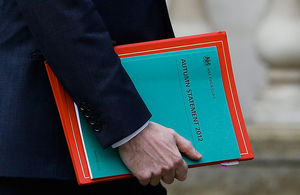Autumn Statement 2012: an overview
A high-level overview of the Autumn Statement, including infographics and a regional map.

The Autumn Statement
The Government’s economic strategy is focused on reducing the deficit, restoring stability, rebalancing the economy and equipping the UK to compete in the global race.
In his statement, George Osborne set out how this strategy will be maintained by taking further action in three areas: Protecting the economy, growth, and fairness.
Protecting the economy
Because of the ongoing impact of the financial crisis, the euro area crisis and the effect of inflation on incomes and business costs, the OBR is predicting a more subdued and uneven recovery than expected, with growth weaker and inflation higher than forecast. In response, the Autumn Statement sets out:
- a further £6.6 billion package of savings from welfare, overseas aid and Departmental spending - funding £5.5 billion of additional infrastructure investment and support for businesses
- a spending envelope for 2015-16 consistent with the announcement in 2011 that spending for 2015-16 and 2016-17 will continue to fall at the same rate as the Spending Review 2010 period
- tax measures that support growth, reward work, help with the cost of living and ensure that those with the most contribute the most
Growth
To enable the UK to compete with emerging economies such as China, India and Brazil, the Government is taking action to rebalance and strengthen the economy while supporting those who want to work hard and get on, including:
- meeting the needs of businesses with a £5.5 billion infrastructure package and support for long-term private investment in new roads, science investment, free schools and academies
- a further one per cent cut in the main rate of corporation tax from April 2014, to 21 per cent
- a significant temporary increase in the Annual Investment Allowance, from £25,000 to £250,000 for two years to support small and medium-sized businesses
- devolution of a greater proportion of growth-related spending to local areas from April 2015, in response to Lord Heseltine’s review of economic growth
- creation of a £1 billion Business Bank to help smaller businesses access finance and support
- enabling UK Export Finance to provide up to £1.5 billion in loans to finance small firms’ exports
- increased funding for UK Trade and Investments and extra support for the GREAT campaign to showcase Britain’s capabilities
View the Growth infographic on Flickr
Fairness
Fairness is a fundamental aspect of plans to reduce the deficit and protect the economy. The Government will help to ensure that it pays to work, supporting pensioners and those most in need, and delivering a progressive tax and welfare system that is affordable and encourages growth, by:
- supporting those on low and middle incomes by increasing the personal allowance by a further £235 in April 2013, taking it to £9440
- cancelling the 3.02 pence per litre fuel duty increase that was planned for 1 January 2013; the 2013-14 increase will be deferred to 1 September 2013 – meaning fuel duty will have been frozen for nearly two and a half years
- from 2014-15, reducing the lifetime allowance for pension contributions from £1.5 million to £1.25 million and the annual allowance from £50,000 to £40,000
- uprating most working age benefits and tax credits by one per cent for three years from April 2013 - excluding disability and carers benefits
- increasing the higher rate threshold for income tax by one per cent rather than inflation in 2014-15 and 2015-16
- increasing the basic State Pension by 2.5 per cent
- targeting the promoters of aggressive tax avoidance schemes and the closure of loopholes
- tackling offshore tax evasion by the creation of a dedicated HMRC unit, maintaining the momentum from the Government’s recent agreements with Switzerland and the US
View the Fairness infographic on Flickr
Where you live
Our regional map shows how the measures announced in the Autumn Statement will affect the people and places near you.
Download the
We’ve also published detailed distributional analysis of the impact of government reforms on households.